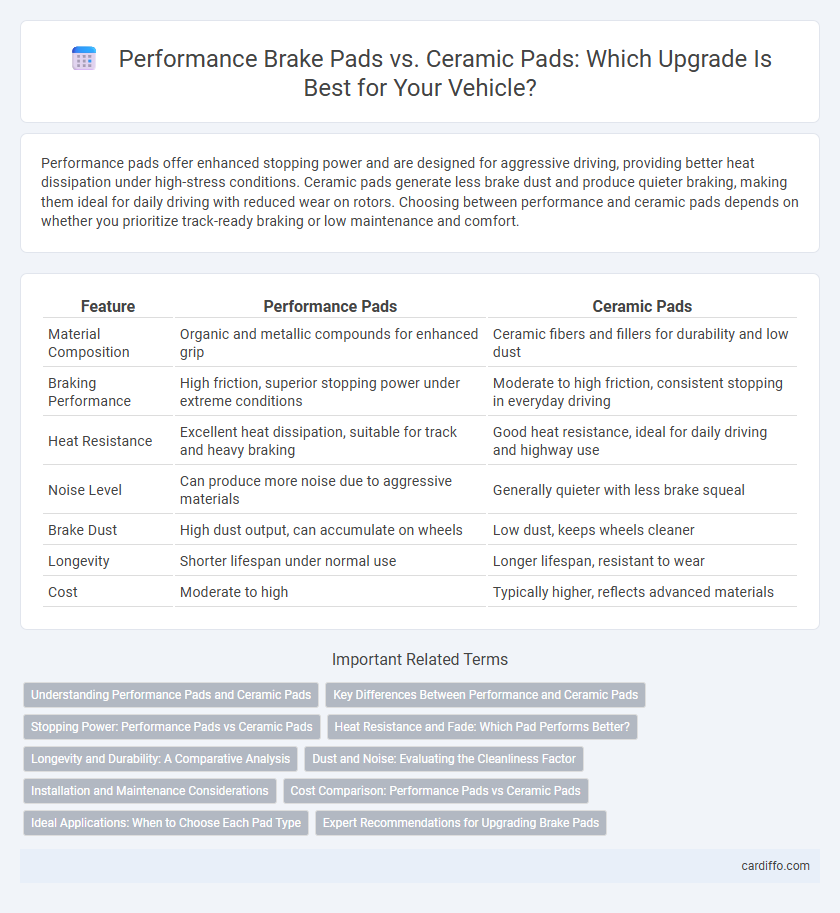Performance pads offer enhanced stopping power and are designed for aggressive driving, providing better heat dissipation under high-stress conditions. Ceramic pads generate less brake dust and produce quieter braking, making them ideal for daily driving with reduced wear on rotors. Choosing between performance and ceramic pads depends on whether you prioritize track-ready braking or low maintenance and comfort.
Table of Comparison
| Feature | Performance Pads | Ceramic Pads |
|---|---|---|
| Material Composition | Organic and metallic compounds for enhanced grip | Ceramic fibers and fillers for durability and low dust |
| Braking Performance | High friction, superior stopping power under extreme conditions | Moderate to high friction, consistent stopping in everyday driving |
| Heat Resistance | Excellent heat dissipation, suitable for track and heavy braking | Good heat resistance, ideal for daily driving and highway use |
| Noise Level | Can produce more noise due to aggressive materials | Generally quieter with less brake squeal |
| Brake Dust | High dust output, can accumulate on wheels | Low dust, keeps wheels cleaner |
| Longevity | Shorter lifespan under normal use | Longer lifespan, resistant to wear |
| Cost | Moderate to high | Typically higher, reflects advanced materials |
Understanding Performance Pads and Ceramic Pads
Performance pads offer superior heat dissipation and enhanced friction properties ideal for aggressive driving, while ceramic pads provide quieter operation and reduced brake dust for everyday use. Performance pads typically feature metallic components that improve stopping power at higher temperatures, whereas ceramic pads use composite materials designed for consistent performance and durability under normal conditions. Choosing between these pads depends on driving style, desired braking efficiency, and maintenance preferences.
Key Differences Between Performance and Ceramic Pads
Performance pads feature enhanced friction materials designed for superior stopping power and heat dissipation, making them ideal for aggressive driving and track use. Ceramic pads provide quieter operation, reduced brake dust, and longer lifespan, prioritizing comfort and maintenance for everyday driving. Key differences include heat resistance, noise levels, and wear rate, where performance pads excel in high-stress conditions and ceramic pads in general-use reliability.
Stopping Power: Performance Pads vs Ceramic Pads
Performance pads deliver superior stopping power due to their aggressive friction compounds designed for high heat resistance and consistent bite during intense braking conditions. Ceramic pads offer a smoother, quieter braking experience with less dust but typically generate less friction, resulting in moderate stopping power compared to performance pads. Choosing performance pads enhances braking efficiency in high-performance and racing applications, while ceramic pads suit everyday driving with balanced stopping power and comfort.
Heat Resistance and Fade: Which Pad Performs Better?
Ceramic brake pads offer superior heat resistance compared to performance pads, maintaining stability under higher temperatures and reducing the risk of brake fade during intense driving conditions. Performance pads often heat up more quickly, leading to faster fade and decreased stopping power over extended use. For drivers prioritizing consistent braking performance and durability under high-heat stress, ceramic pads provide a more reliable solution.
Longevity and Durability: A Comparative Analysis
Performance pads offer enhanced initial braking power but tend to wear faster than ceramic pads, which are engineered for extended longevity and consistent performance over time. Ceramic pads feature a harder compound that resists high temperatures and minimizes wear, resulting in longer service intervals and reduced replacement frequency. The durability of ceramic pads translates to cost savings and reliability, making them a preferred choice for everyday driving and long-term use.
Dust and Noise: Evaluating the Cleanliness Factor
Performance pads generate less dust compared to ceramic pads, resulting in a cleaner wheel surface and reduced brake system contamination. Ceramic pads tend to produce finer dust particles that adhere less to wheels but may accumulate more inside brake components. Noise emission is generally lower with ceramic pads, offering quieter braking performance, whereas performance pads can produce higher squeal levels under aggressive driving conditions.
Installation and Maintenance Considerations
Performance brake pads require careful installation to ensure optimal contact and may need bed-in procedures for maximum effectiveness. Ceramic pads, known for easier installation, produce less dust and noise, reducing the frequency of cleaning and maintenance. Both types demand routine inspections, but ceramic pads typically offer longer lifespan and lower wear on rotors, minimizing overall upkeep.
Cost Comparison: Performance Pads vs Ceramic Pads
Performance brake pads typically offer a lower upfront cost compared to ceramic pads, making them a budget-friendly option for many drivers. Ceramic pads, while more expensive initially, provide longer lifespan and reduced brake dust, potentially lowering maintenance expenses over time. Evaluating the total cost of ownership involves considering the initial purchase price, replacement frequency, and associated maintenance costs for both Performance and Ceramic brake pads.
Ideal Applications: When to Choose Each Pad Type
Performance pads excel in high-friction braking situations, making them ideal for aggressive street driving and occasional track use where strong initial bite and consistent stopping power are required. Ceramic pads are better suited for daily driving due to their quieter operation, lower dust production, and smoother braking feel under normal conditions. Choosing between these pads depends on your driving style and environmental conditions, with performance pads favored for heavy-duty use and ceramic pads for comfort and low maintenance.
Expert Recommendations for Upgrading Brake Pads
Expert recommendations for upgrading brake pads often highlight ceramic pads for their superior performance, offering quieter operation, less brake dust, and longer lifespan compared to performance pads. Performance pads excel in high-temperature conditions, making them ideal for racing or aggressive driving due to their enhanced stopping power and heat dissipation. Choosing between ceramic and performance brake pads depends on driving style and priorities, with experts advising ceramic pads for daily driving and reliability, while performance pads suit track and performance-oriented vehicles.
Performance Pads vs Ceramic Pads Infographic

 cardiffo.com
cardiffo.com